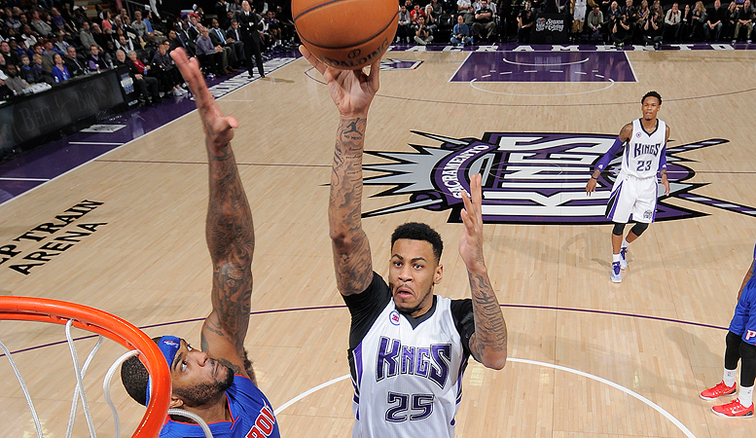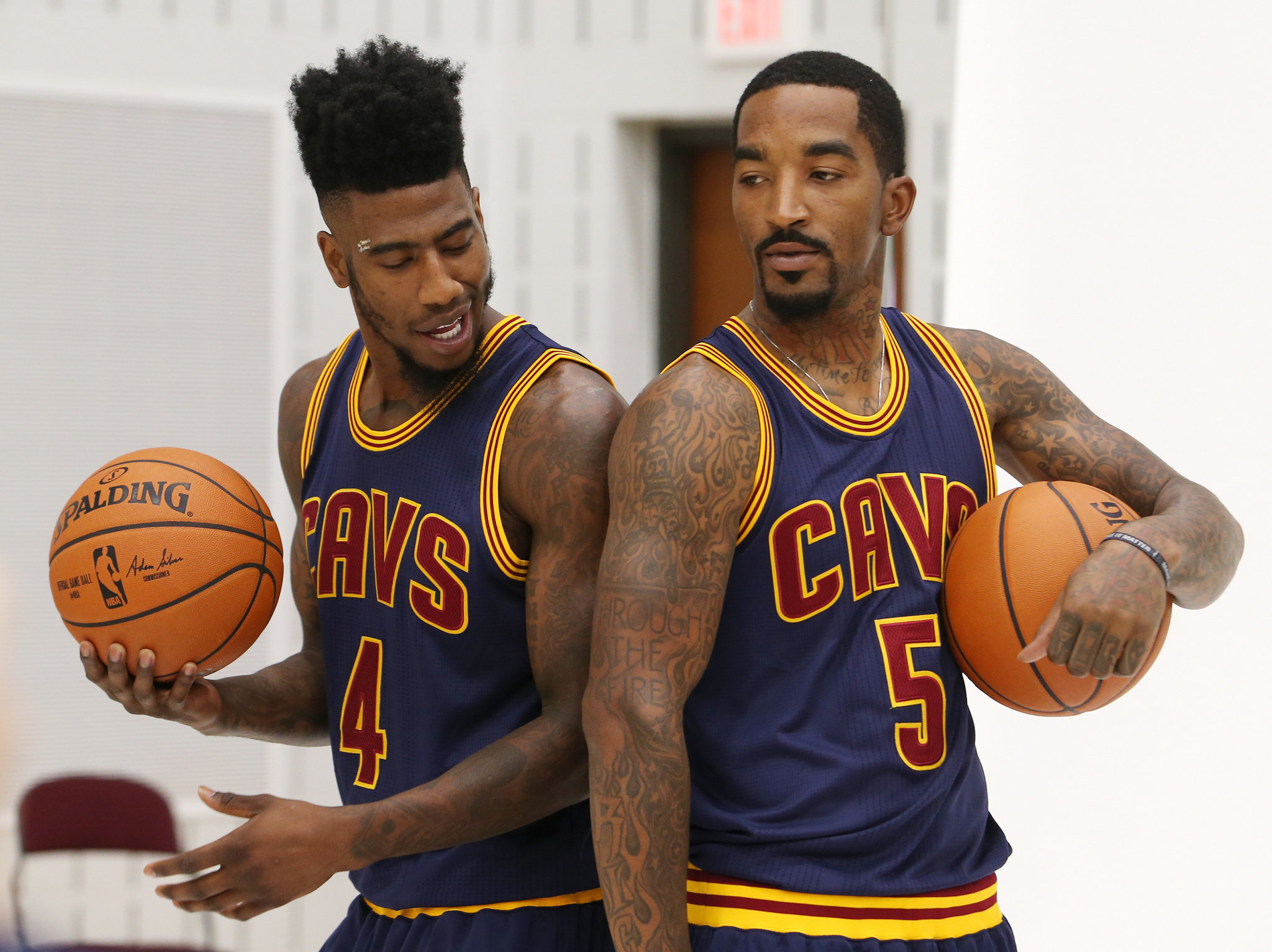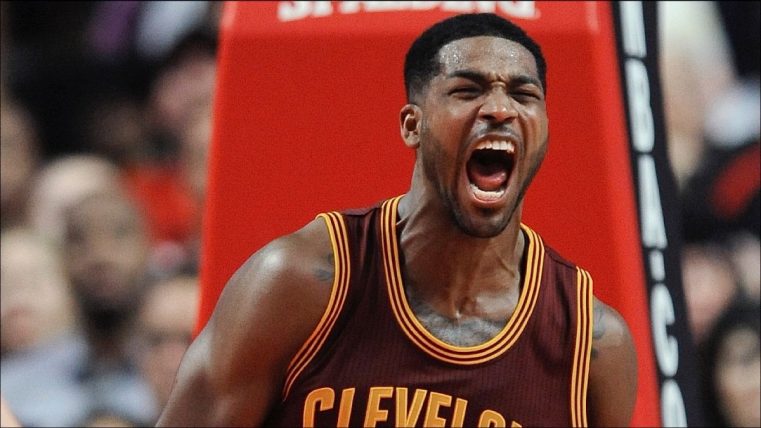
Cavs Bring Moreland to Training Camp
2016-09-20
As summer winds down and fall approaches, the Cleveland Cavaliers will bring in several players on training camp deals. As these signings happen, Cavs: The Blog will take some time to profile each player and what they could bring to the team. Today’s profile takes a look at forward/center Eric Moreland.
With training camp just around the corner, the Cavaliers seem to be one J.R. Smith re-signing away from having the team set the way they want it. This team has built its identity around a few focal points. Obviously there’s the Big Three of LeBron James, Kyrie Irving, and Kevin Love, but there’s also the Cavaliers’ focus on outside shooting, rebounding, and having players with the length and ability to switch defensively. One area that the Cavaliers haven’t truly addressed is rim protection. Among their big men, Tristan Thompson and Channing Frye are inconsistent in this area, Chris Andersen is past his prime, and Love is a complete non-factor in that regard. While James provided terrific rim protection in the NBA Finals, it is unfair to ask this of him throughout the 82 game regular season. The Cavaliers could use a bench player who could come in and block some shots on nights when teams are getting to the rim too easily. Enter Eric Moreland.
Like the other players the Cavaliers are bringing in on training camp deals, Moreland has NBA experience, but not as much as it might seem at first glance. Despite being on the Sacramento Kings’ roster for the entirety of the past two seasons, Moreland has only appeared in 11 NBA games for a total of 50 minutes. During that same period, Moreland has also only played in 12 games totaling 336 minutes for the Reno Bighorns, Sacramento’s D-League affiliate. It’s hardly the way for a young player to hone his game, but it’s also been characteristic of Moreland’s experiences at the collegiate and professional levels.
Originally signing with UTEP in January of 2010, Moreland asked for a release from his scholarship after UTEP let go of head coach Tony Barbee. He then signed with Oregon State after the NCAA cleared him to play that fall with all four years of his eligibility intact. Unfortunately for Moreland, he suffered a season-ending injury just four games into his freshman season. He was then granted a medical hardship, meaning he still had four years of college eligibility.
The following season, Moreland played in all 36 of Oregon State’s games as a redshirt freshman, leading the Pac-12 in blocked shots. He also set Oregon State’s single-season record for blocked shots with 69. At 6’10” with a massive 7’3.5″ wingspan, Moreland has the kind of length that is characteristic of good rim protectors. The next season was even better, as Moreland blocked 73 shots on his way to averaging 9.4 points, 10.6 rebounds, and 2.5 blocks per game and was Pac-12 All-Defensive Honorable Mention. He began to show some moves around the basket and even made six threes in 19 chances, and posted a true shooting percentage of 59.1. At this point, Moreland seemed to be putting things together.
Unfortunately, that all unraveled the next year. Moreland missed the first 12 games of that season after he was suspended for an unspecified violation of teams rules. This kind of situation is a red flag for NBA teams, and Moreland’s draft stock likely plummeted before he even played a game. When he did return to the court, Moreland wasn’t the same player he was the year before. While his counting stats only decreased slightly, Moreland’s two-point percentage dropped from 60.4% the year prior to 50.8%. His offensive rating also dropped by eight points per 100 possessions, while he defensive rating rose by nearly the same amount. At 22 years old, Moreland was regressing when he should have been dominating younger competition. He went from prospect to suspect, and it was no surprise when he wasn’t selected after declaring for the 2014 NBA Draft.
After going undrafted, Moreland joined the Kings for the 2014 NBA Summer League, and was then signed for the 2014-2015 season. Considered a project big man despite his age, Moreland played just three games (totaling two minutes) with the Kings and seven with the Bighorns before being ruled out for the rest of the season due to a labral tear in his left shoulder. He recovered in time to join the Kings for the 2015 NBA Summer League, was later waived, and then re-signed before training camp. Moreland once again made the Kings’ roster, but missed eight weeks after he fractured his left foot on December 15th of last year. Moreland did appear in eight games with the Kings, and five more with the Bighorns last season—and played fairly well during his time in the D-League—but simply hasn’t had enough game time over the past two seasons to develop any further.
So what does this mean for Moreland and the Cavaliers? There’s no doubt that Moreland’s injuries the past two seasons have helped to stunt his growth, but playing for a dysfunctional franchise like the Kings likely hasn’t helped either. Moreland remains very good around the basket, averaging 13.3 rebounds and 2.1 blocks in 28 minutes per game for the Bighorns over the past two seasons. He’s a good athlete, but not quite an elite one, and is on the small side for a center, particularly since he weighs just 238 pounds. Another worry is his free throw shooting. Moreland has shot just 34% from the line during his time in the D-League, far lower than he did at Oregon State or with the Kings. Since his field goal percentage has fluctuated between good and mediocre at the collegiate and professional levels, this makes Moreland a net negative on offense.
He isn’t as polished as fellow big man Corey Jefferson, with whom he may be competing for a roster spot, and would have trouble beating out the likes of DeAndre Liggins or Markel Brown if the Cavaliers only keep one training camp invitee. That being said, Moreland’s rebounding and shot blocking give him two NBA skills, and he may have the most upside of any of the players the Cavaliers are bringing to camp, particularly if he can develop into a roll man in the mold of DeAndre Jordan or Hassan Whiteside, something he has struggled to do in his career as he doesn’t quite have their size or athleticism. Still, if Moreland can develop into even a very poor man’s version of either of those players then he could be a pleasant surprise for the Cleveland Cavaliers or more likely, the Canton Charge.



I just wanted to pop in here and talk for a second about Allen Iverson getting inducted to the hall of fame. He’s tied for my favorite non-Cavs player ever, he brought such innovation to the game, he ushered in our era in so many interesting ways, and his speech at the induction made me remember why I love this sport that was terrible at playing. I don’t want to link stuff here but check out his induction speech adn his BBallbreakdown tribute.
Iverson was indeed awesome. One of my favorites as well. Just a tremendously great player and teammate. That he got that team to the Finals is crazy to think about.
I wrote abt this in last Wednesday ‘s point forward.
JUST GOT MY FREE CAVS / SCRIMMAGE TICKETS FOR NEXT SUNDAY/ OCT 2ND—-ANY OTHER BLOGGERS GOING TO BE THERE ?—–
I’m pretty excited about the 6’5″ guy with a 6’10” wingspan in camp. I bet he has a pretty good season.
I really don’t see how we have any rim protection problems. We got rid of one of our worst players last year in Mozgov and now get Frye for an entire year. Add in the Birdman and we are much better at center than last year.
TT is still there
Frye is much better than Mozgov (for every year except the 6 month stretch just after we traded for him)
Birdman has to be better than Kaun.
1. “Birdman has to be better than Kaun.” Obviously true, but since Kaun never played, this is a meaningless statement. 2. “Frye is much better than Mozgov (for every year except the 6 month stretch just after we traded for him)”. But those six months suggest Mozgov’s ceiling, which was pretty darn good. Frye might be overall better, but it as a shooter, not in rim protection. So we got major rim protection issues. Particularly if the pendulum swings back toward more dominant big men. If a young Shaq or Wilt came into the league right now, they would score… Read more »
I don’t know. I mean we faced Drummond in the playoffs and TT more than won that matchup.
I don’t think basketball history will be talking about the big three of Drummond, Wilt, and Shaq.
Whatever you want to argue, you can’t argue that Moz, was a solid rim protector. He was also vastly superior to bird man. Cavs will struggle with more dominant centers in the regular season. They’ve been able the overcome it by scheme and effort in the postseason.
They won’t though. Any solid centers they’ve faced have been neutralized because TT is really good at what he does. Mogov sucked last year. Frye is a huge huge upgrade over him. Overall our frontcout depth is much better this year than last year.
Apparently “in the regular season” is not a phrase that registers with you. Cavs struggled plenty of times in the region season against good centers and will continue to.
Would like to see Moreland make the Charge and get some consistent playing time.
EVEN THOUGH HE DIDN’T SEE MUCH PLAYING TIME HE WAS GOING AGAINST DEMARCUS EVERYDAY AT PRACTICE / HOPING LEBRON CAN ” MENTOR ” HIS PERSONALITY AND HIS TALENTS WILL SURFACE EITHHER WEARING A CAVS OR CANTON UNIFORM ( AND THEN CAVS DOWN THE ROAD ) MAY HAVE FOUND A DIAMOND IN THE ROUGH ——STAY TUNED
Hassan Whiteside Lite without the attitude problems.
Not sure you can say without the attitude problems. Don’t know what he was suspended for in college.
That is true enough. We also haven’t seen enough of him to know if he will be a walking technical like Whiteside is.